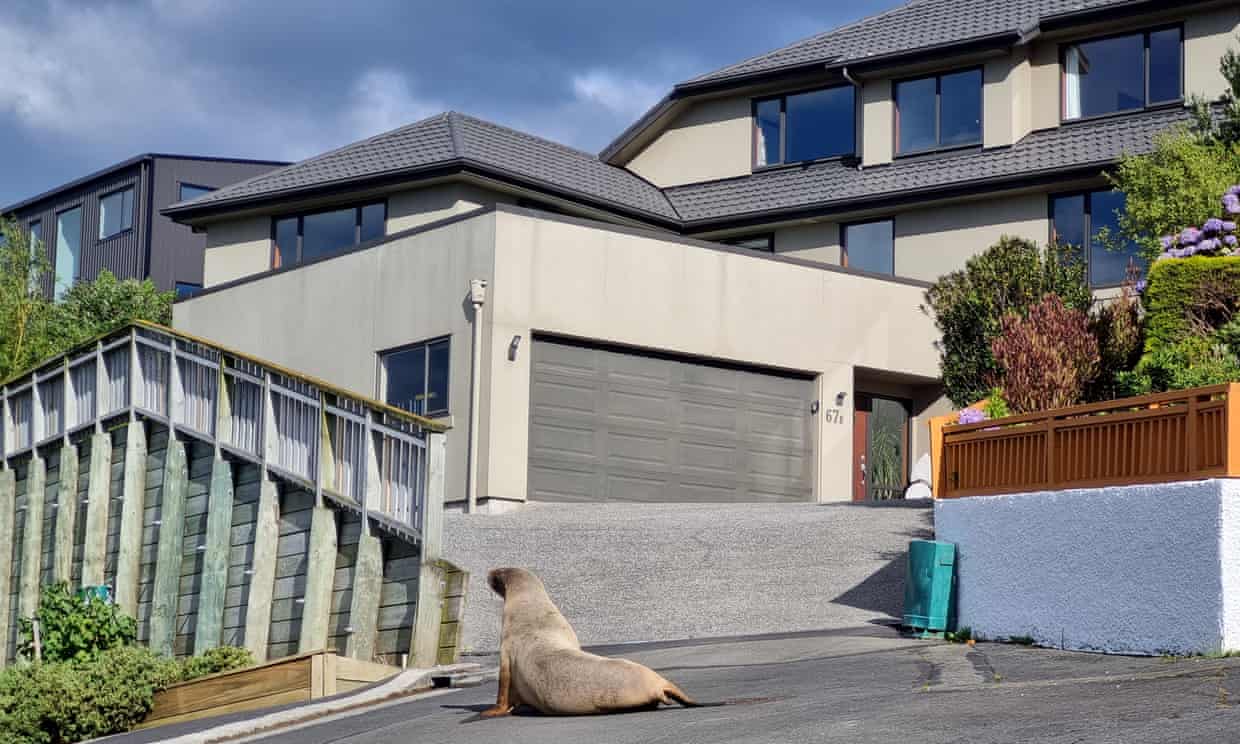Animals have been popping up on golf courses and surfing contests in Dunedin as they reestablish a foothold on the South Island
Charlotte Graham-McLay in Wellington
A growing population of sea lions in the New Zealand city of Dunedin is provoking “overlapping chaos” as their breeding season coincides with residents enjoying peak summer weather.
Two sea lions gave birth on a golf course, another swam alongside competitors in a surfing contest. Others have been spotted crossing roads as Dunedin’s sea lion “silly season”, which runs from mid-December to mid-January, is in full swing.
Jim Fyfe, a biodiversity ranger for the department of conservation, spends the Christmas period poised to herd the “charismatic, clever and curious” animals – which can travel kilometres inland – out of gardens and off roads.
“They’re not wanting to cause a fuss,” Fyfe said. But sometimes they do: this month he received a call from a golfer that a mother and her pup were holding up play on the fairway at Chisholm Links golf course.

“I said, ‘I’ll come right down, but leave them five minutes and they’ll be out of your way,’” he said, adding: “Sorry for the inconvenience.”
“The coincidence of sea lion breeding season and people having holidays is complete overlapping chaos,” he said.
The annual breeding season is part of a conservation success story that observers hope could help to halt the decline of one of the world’s rarest sea lion species, and it has also prompted questions about how the animals can flourish in urban areas unused to them.
In 1993, a century after New Zealand sea lions were driven to subantarctic islands by hunting on the mainland, one unexpectedly returned to Dunedin to give birth. Thirty years later, 34 breeding females descended from that first sea lion have “pretty complete coverage” of the city’s sandy beaches this month as they “hide away” to give birth, Fyfe said.
In past years, sea lions have frolicked in the city’s saltwater pools, disrupted a football match, stolen shoes, and crashed picnics. Fyfe said the residents of Dunedin – population 135,000 – are adapting.

“Sea lions sell themselves to some extent and people just fall in love with them,” Fyfe said, adding that the animals have the brain size of 10-year-old children and better spatial memory than humans.
“Once people realise that they’re not actually aggressive or a threat they relax around them and then it’s a double edged sword of saying, OK, but they are wild animals.”
Strategies in preparation for the breeding season include road signage to urge driver caution, deployment of conservation rangers over the Christmas period, requests from the city council to keep dogs on leads in parts of Dunedin, and the recruitment of local sea lion lovers to keep an eye on escapades in their neighbourhoods.
In 2021, Dunedin city council closed a busy road for a month to allow for beach access for a sea lion and her pup, and traffic remains a major threat to the animals as the population grows. Last month a four-year-old male sea lion was hit by a car and killed.
Rangers have recorded “a lot more issues with sea lions coming across roads” as male sea lions – which seek out the smaller females during breeding seasons, driving them inland – remain on New Zealand’s mainland for breeding season, rather than returning to the subantarctic Auckland Islands, said Fyfe.
The re-emergence of sea lions on New Zealand’s South Island has happened alongside the steep decline of the Auckland Islands breeding colony, which is thought to number 10,000 -12,000 animals.
The animals’ enthusiasm for Dunedin is a cause for optimism, Fyfe said, but the Otago Peninsula – where Dunedin is located – is still about a decade away from formal classification as a breeding colony. A site must record the birth of at least 35 pups for five consecutive years to meet the definition. This summer, 11 pups have been born in Dunedin of an expected 25.
“For people on the coast in New Zealand, there is a conversation going on right now about climate change and sea level rise and what that’s going to mean for our coastal infrastructure,” Fyfe said.
“We also need to think about sea lion habitat requirements, because this is a great opportunity to make that room.”
